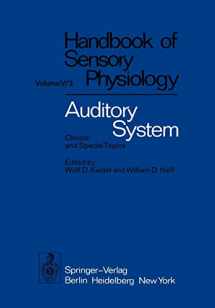
Auditory System: Clinical and Special Topics (Handbook of Sensory Physiology, 5 / 3)
ISBN-13:
9783642660849
ISBN-10:
3642660843
Edition:
Softcover reprint of the original 1st ed. 1976
Author:
Steele, H. Davis, E. de Boer, W. Connor, J.J. Eggermont, R. Galambos, C.D. Geisler, G.M. Gerken, H.E. von Gierke, C.S. Hallpike, E.Jr. Hawkins, S.A. Hillyard, W.D. Keidel, D.E. Parker, T.W. Picton, W. Rudmose, F.B. Simmons, G. Stange
Publication date:
2011
Publisher:
Springer
Format:
Paperback
818 pages
FREE US shipping
Book details
ISBN-13:
9783642660849
ISBN-10:
3642660843
Edition:
Softcover reprint of the original 1st ed. 1976
Author:
Steele, H. Davis, E. de Boer, W. Connor, J.J. Eggermont, R. Galambos, C.D. Geisler, G.M. Gerken, H.E. von Gierke, C.S. Hallpike, E.Jr. Hawkins, S.A. Hillyard, W.D. Keidel, D.E. Parker, T.W. Picton, W. Rudmose, F.B. Simmons, G. Stange
Publication date:
2011
Publisher:
Springer
Format:
Paperback
818 pages
Summary
Auditory System: Clinical and Special Topics (Handbook of Sensory Physiology, 5 / 3) (ISBN-13: 9783642660849 and ISBN-10: 3642660843), written by authors
Steele, H. Davis, E. de Boer, W. Connor, J.J. Eggermont, R. Galambos, C.D. Geisler, G.M. Gerken, H.E. von Gierke, C.S. Hallpike, E.Jr. Hawkins, S.A. Hillyard, W.D. Keidel, D.E. Parker, T.W. Picton, W. Rudmose, F.B. Simmons, G. Stange, was published by Springer in 2011.
With an overall rating of 4.3 stars, it's a notable title among other
Practice Management & Reimbursement
(Administration & Medicine Economics, Audiology & Speech Pathology, Allied Health Professions) books. You can easily purchase or rent Auditory System: Clinical and Special Topics (Handbook of Sensory Physiology, 5 / 3) (Paperback) from BooksRun,
along with many other new and used
Practice Management & Reimbursement
books
and textbooks.
And, if you're looking to sell your copy, our current buyback offer is $0.3.
Description
after heated and often bitter debates, SIEBENMANN'S opinion finally prevailed, i. e. , a contribution to cochlear lesions due to vibrations of the floor transmitted via bone conduction could not be demonstrated. For one thing, it was hard to see how appreciable amounts of energy could reach the ears in this manner, considering the attenuation that is bound to occur across each of the many joints along the pathway involved. In some older audiological surveys conducted in industry (e. g. , TEMKIN, 1933), groups of workmen were found who displayed signs of apical-turn lesions, i. e. , low-tone hearing losses for air and for bone. Such lesions could not be expected to results from exposure to air-borne sounds because of the low-frequency attenu ation of the middle ear. Although WITTMAACK'S explanation, which was frequently invoked in such reports, does no longer appear tenable, such apical-turn lesions could conceivably be caused by bone conduction components of high-intensity noise in the sense of BEKESY (1948). - As far as I am aware of, no newer studies have been conducted in this problem area, and the older experiments and/or surveys were done at times before signal parameters could be precisely controlled or measured. A detailed, critical review of the older studies on the potential contribution of bone-conducted energy to industrial hearing loss and its underlying pathology may be found in Werner (1940) who, incidently, favored SIEBENMANN'S point of VIew.


We would LOVE it if you could help us and other readers by reviewing the book
Book review

Congratulations! We have received your book review.
{user}
{createdAt}
by {truncated_author}


